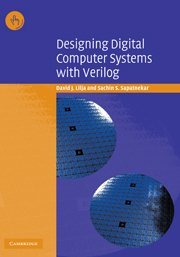Book contents
- Frontmatter
- Contents
- Preface
- 1 Controlling complexity
- 2 A Verilogical place to start
- 3 Defining the instruction set architecture
- 4 Algorithmic behavioral modeling
- 5 Building an assembler for VeSPA
- 6 Pipelining
- 7 Implementation of the pipelined processor
- 8 Verification
- A The VeSPA instruction set architecture (ISA)
- B The VASM assembler
- Index
- VeSPA Instruction Set
Preface
Published online by Cambridge University Press: 31 October 2009
- Frontmatter
- Contents
- Preface
- 1 Controlling complexity
- 2 A Verilogical place to start
- 3 Defining the instruction set architecture
- 4 Algorithmic behavioral modeling
- 5 Building an assembler for VeSPA
- 6 Pipelining
- 7 Implementation of the pipelined processor
- 8 Verification
- A The VeSPA instruction set architecture (ISA)
- B The VASM assembler
- Index
- VeSPA Instruction Set
Summary
To the engineer, all matter in the universe can be placed into one of two categories: (1) things that need to be fixed, and (2) things that will need to be fixed after you've had a few minutes to play with them.
Quoted by Scott Adams in The Dilbert Principle.Hardware description languages (HDLs) are used extensively in industry to design digital systems ranging from microprocessors to components within consumer appliances, such as cellular telephones. These languages allow engineers to quickly and precisely specify and document their designs in a high-level language that has strong similarities to conventional programming languages, such as Java, C, and C++. Automatic tools exist to simulate the design using this high-level description and, ultimately, to translate the design from the hardware description language into an actual silicon chip.
There are two primary hardware description languages in use by industry today, Verilog and VHDL. Both languages solve the same basic problem, but in slightly different ways. There are strong adherents to both languages and arguments about which is better often seem to have the feel of a religious war. The Institute of Electrical and Electronic Engineers (IEEE) made Verilog an international standard in 1995 and it continues to be refined and enhanced.
Numerous books have been written to describe both languages. These books range from the IEEE standards document, to tutorial texts that introduce the language to novices, to texts for advanced users that describe the many subtle aspects of the languages. However, these books tend to treat the languages as just another programming language to be learned.
- Type
- Chapter
- Information
- Designing Digital Computer Systems with Verilog , pp. vii - xPublisher: Cambridge University PressPrint publication year: 2004

